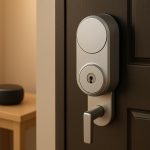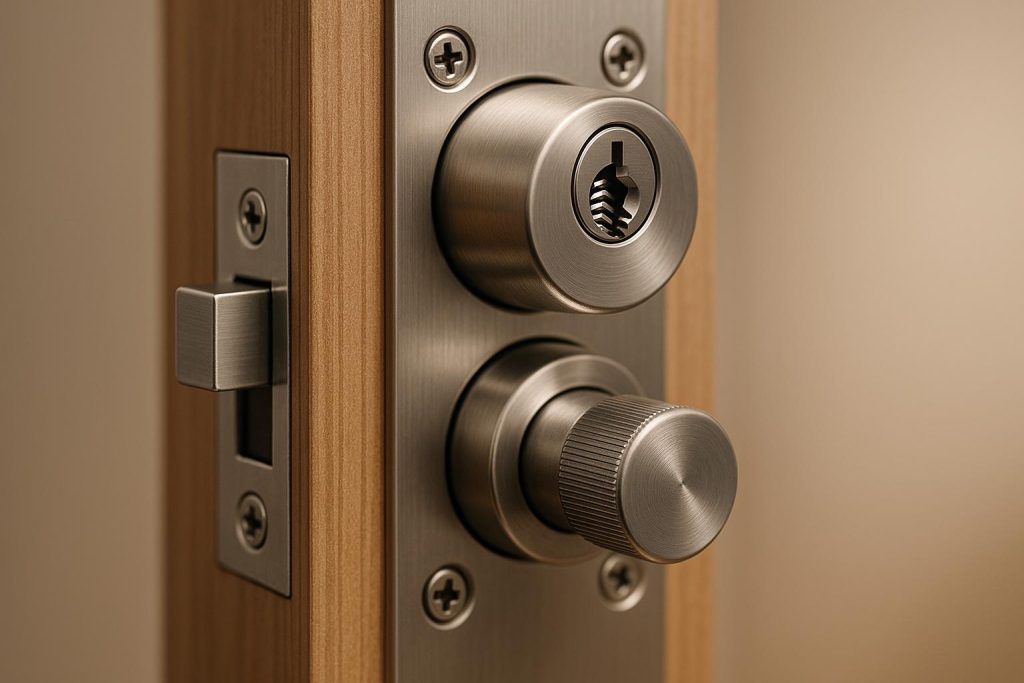When it comes to securing your property, anti-pick locks and anti-bump locks address two different threats: lock picking and lock bumping. Lock picking requires skill and tools to manipulate a lock’s internal pins, while lock bumping uses a special key and force to quickly open a lock. Both methods exploit weaknesses in standard locks, but they differ in execution and complexity.
Here’s the key takeaway:
- Anti-pick locks: Designed to resist skilled manipulation by using advanced mechanisms like security pins, sidebars, and complex keyways. Ideal for high-security needs.
- Anti-bump locks: Prevent force-based attacks by disrupting the energy transfer from bump keys. Best for residential properties and quick protection against common break-ins.
Quick Comparison
| Feature | Anti-Pick Locks | Anti-Bump Locks |
|---|---|---|
| Threat Countered | Lock picking | Lock bumping |
| Skill Required | High (expertise needed) | Low (easy to learn) |
| Attack Speed | Slow (minutes) | Fast (seconds) |
| Noise Level | Silent | Minor noise |
| Best For | High-security areas | Homes, small businesses |
| Cost | $150–$400 (plus $100–$200 install) | $50–$150 (plus $75–$125 install) |
Both options improve security, but the choice depends on your specific risks. For urban homes or small businesses, anti-bump locks are practical. For high-value assets or sensitive areas, anti-pick locks offer stronger protection. Proper installation and maintenance are key to maximizing their effectiveness.
Brinks Brand “HIGH SECURITY” Bump & Pick Resistant Door Locks – Gut & Rekey
Understanding Lock Picking and Lock Bumping Threats
Before exploring solutions, it’s important to grasp the specific risks that anti-pick and anti-bump locks are designed to address. Both lock picking and lock bumping exploit weaknesses in traditional pin tumbler locks, but they do so in entirely different ways. Let’s take a closer look at each method to understand these vulnerabilities.
What Is Lock Picking?
Lock picking involves manipulating a lock’s internal components to open it without using the original key. This technique relies on specialized tools, such as a tension wrench and various pick tools like hook picks, rake picks, and diamond picks.
The process works by taking advantage of the tolerances within standard pin tumbler locks. A tension wrench applies gentle rotational pressure to the lock’s cylinder, while pick tools are used to lift each pin to the correct height. Once all the pins align at the shear line – the point where the lock’s cylinder meets its housing – the cylinder rotates freely, unlocking the mechanism.
What makes lock picking particularly concerning is its stealthy nature. A skilled individual can open many residential locks in less than two minutes, often leaving no visible signs of tampering. However, mastering this method requires significant practice, fine motor skills, and a thorough understanding of lock mechanics. For this reason, lock picking is typically associated with individuals who have specialized training or criminal intent.
Now that we’ve covered lock picking, let’s move on to another method that takes a very different approach to exploiting traditional locks.
What Is Lock Bumping?
Lock bumping, on the other hand, relies on a specially made bump key – a key cut to its deepest possible notches across all positions – and a striking motion to quickly align the pins.
The process is surprisingly straightforward. The bump key is inserted into the lock, leaving a small gap of about one pin’s width. The attacker then strikes the key with a small tool, such as a hammer or screwdriver handle, while applying slight rotational pressure. This strike transfers kinetic energy through the pins, causing the top and bottom pins to momentarily separate at the shear line, allowing the lock to open.
Speed is the hallmark of lock bumping. A lock can be opened in under 10 seconds, making it an attractive option for opportunistic criminals. Unlike picking, bumping requires very little skill or practice. In fact, most people can learn the technique in just a few minutes by watching online tutorials.
Adding to the problem is the easy availability of bump keys. These keys can be purchased online or created from existing keys with basic filing tools, making bumping a common method for non-destructive entry in residential break-ins.
Both techniques highlight the need for locks specifically designed to resist these kinds of attacks.
Key Differences Between Picking and Bumping
Understanding the differences between these two methods helps clarify why distinct security measures are necessary to counter each threat. Lock picking can take anywhere from 30 seconds to several minutes and requires a high level of skill and precision. In contrast, bumping is much faster, often taking just seconds, and requires minimal effort or expertise.
The skill level required also varies greatly. Lock picking demands years of practice, excellent fine motor control, and an in-depth knowledge of lock mechanics. Many professional locksmiths spend years perfecting their technique. Bumping, however, is much simpler – it can be learned in an afternoon and requires only basic coordination.
Another key distinction lies in the evidence left behind. Lock picking is nearly silent and leaves no physical traces, making it difficult to detect. Bumping, while quick, can leave minor scratches around the keyway and creates some noise when the key is struck. However, because the process is so brief, it often goes unnoticed.
These differences underscore the need for comprehensive security solutions. A lock that can resist one method may still be vulnerable to the other. By understanding these attack methods, property owners can make better decisions about the security features that best suit their needs and risks.
Anti-Pick Locks: How They Work and Benefits
Anti-pick locks are designed to tackle the vulnerabilities of traditional locks by incorporating advanced features that make lock picking highly challenging. These locks are a step forward in securing homes and businesses, offering robust protection against intruders using standard picking techniques.
How Anti-Pick Locks Work
What sets anti-pick locks apart is their combination of advanced mechanisms that work together to block unauthorized access. Unlike standard pin tumbler locks, these locks are built with intricate designs that make traditional picking tools ineffective.
One key feature is specialized high-security keys. These keys are thicker and have complex grooves that correspond to equally intricate internal mechanisms. This design not only resists duplication but also frustrates lock-picking attempts.
Another important component is the sidebar system, which adds an extra layer of security. For the lock to open, the sidebar must align perfectly with all the pins, a task that standard picking methods cannot easily achieve.
Additional tumblers further complicate the process. While a typical lock might have five or six pins, anti-pick locks often include extra tumblers that must align simultaneously. Take the BiLock deadbolt system, for instance. It uses 12 pins arranged in two rows, making it exponentially more difficult to pick.
Security pins – such as spool, serrated, and mushroom pins – are another innovation. These pins are designed to mislead pickers by providing false feedback, making it harder to manipulate the lock.
Some systems, like the EVVA MCS locking system, combine magnetic and mechanical elements. These locks require specially designed keys that integrate both physical and magnetic features, making them resistant to both picking and 3D-printed replicas.
The Medeco M3 Cam Lock takes a different approach, offering robust resistance to both picking and bumping attacks. This comprehensive design reflects the diverse strategies manufacturers use to increase security.
These advanced features make anti-pick locks a powerful deterrent against unauthorized entry, but they also come with some practical considerations.
Pros and Cons of Anti-Pick Locks
Anti-pick locks provide a strong layer of security, especially for properties requiring enhanced protection. Their primary advantage lies in their resistance to traditional picking techniques, making them an excellent choice for safeguarding high-value assets or sensitive areas.
"Anti-pick locks are, conventionally, unable to be picked even by a professional locksmith. However, plenty of tools can still disable and break a lock. Nothing is ever truly impossible, just highly improbable. That said, you should feel pretty safe from being lockpicked with an anti-pick lock." – ButterflyMX Blog
These locks also act as a deterrent. Opportunistic intruders, who often lack the expertise and tools to bypass such sophisticated systems, are likely to avoid properties equipped with anti-pick locks and seek easier targets instead.
For businesses handling confidential information, homeowners with valuable possessions, or properties in areas with high crime rates, anti-pick locks offer a level of security that standard locks simply can’t match.
However, there are a few trade-offs to consider. Anti-pick locks are generally more expensive than traditional locks, and replacing or duplicating keys can be both inconvenient and costly. For example, systems like BiLock require replacement keys to be obtained exclusively through authorized dealers.
Installation can also be more complex. High-end systems often require professional locksmiths for proper mounting, adding to the cost. Additionally, the specialized nature of these locks means not all technicians are familiar with their mechanisms, which could result in longer wait times or higher service fees in emergency situations.
Despite these challenges, anti-pick locks are a worthwhile investment for anyone prioritizing security. Consulting with a professional locksmith can help you choose the right lock that balances protection with practicality.
Anti-Bump Locks: How They Work and Benefits
Anti-bump locks are specifically designed to counter the threat of bump key attacks – a technique where kinetic energy is used to manipulate traditional locks. These locks include clever design features that make this method of bypassing locks nearly impossible.
How Anti-Bump Locks Work
The magic of anti-bump locks lies in their ability to absorb or counteract the energy transfer from a bump key. They employ a variety of mechanisms to ensure that their internal components remain unresponsive to external tampering.
- Mushroom pins: These pins have wider tops that catch against the cylinder walls when struck. This prevents the smooth rotation required to open the lock, effectively stopping the bump key in its tracks.
- Spool pins: With their narrow waists, spool pins create a "false set" when impacted. This binding action keeps the cylinder from turning, even if the other pins temporarily align.
- Telescoping pins: These pins compress and then expand rapidly under impact, disrupting the alignment needed for the lock to open. This timing mechanism ensures that the brief alignment caused by bumping is too short to be effective.
- Modified key blanks: Some systems, like the ASSA Twin series, use unique key profiles that standard bump keys cannot replicate. These designs often require keys to engage multiple sets of pins simultaneously, rendering bump keys useless.
- Electronic components: Advanced locks integrate electronic features such as proximity sensors or magnetic elements alongside mechanical mechanisms. These dual-authentication systems make bumping techniques irrelevant.
- Mul-T-Lock Interactive+ system: This system combines several anti-bump features, including telescoping pins, unique key profiles, and a sidebar mechanism for added security. Its layered design ensures protection even if one feature is compromised.
These features not only thwart bump key attacks but also make anti-bump locks practical for everyday use, as they are relatively easy to install and cost-effective compared to more complex security systems.
Pros and Cons of Anti-Bump Locks
Anti-bump locks provide a targeted solution for property owners concerned about this specific type of attack. Here’s a closer look at their strengths and limitations:
Advantages:
- Silent protection: Bump key attacks are quick, quiet, and leave little evidence of tampering. Anti-bump locks eliminate this vulnerability, forcing intruders to resort to noisier, more detectable methods – or to give up entirely.
- Ease of installation: Many anti-bump locks are designed to fit standard doors, avoiding the need for costly modifications. This makes them accessible for both residential and commercial properties.
- Affordable security: While anti-bump locks are pricier than standard locks, they are less expensive than full high-security systems. This makes them an attractive option for those looking for enhanced protection without breaking the bank.
Limitations:
- Narrow focus: These locks excel at preventing bump key attacks but may not offer additional protection against other methods like picking, drilling, or brute force.
- Key availability: Replacement keys often need to be ordered through specific dealers or manufacturers, which can be inconvenient during emergencies – especially for businesses requiring quick access to spare keys.
- Installation needs: While many systems can be installed by experienced DIYers, some advanced models require professional installation to function properly and maintain their warranty.
- False sense of security: Relying solely on anti-bump locks can lead to overconfidence. They address one specific threat but aren’t a comprehensive solution to all security risks. A well-rounded approach should consider other vulnerabilities as well.
For residents and business owners in urban areas like Pittsburgh, PA, anti-bump locks can be a smart investment. The quick and discreet nature of bump key attacks makes them appealing to criminals in densely populated environments, so having this added layer of protection can make all the difference in safeguarding a property.
sbb-itb-643e28e
Anti-Pick vs. Anti-Bump Locks: Side-by-Side Comparison
Knowing the differences between anti-pick and anti-bump locks can help you make a more informed choice for your security needs. Both options go beyond standard pin-and-tumbler locks, but they tackle different types of threats with unique approaches.
Comparison Table: Anti-Pick vs. Anti-Bump Locks
| Feature | Anti-Pick Locks | Anti-Bump Locks |
|---|---|---|
| Primary Threat | Skilled lock picking with specialized tools | Bump key attacks using a force-based technique |
| Protection Mechanism | Complex pin designs, unique keyways, multiple pin rows | Security pins, springs, shallow pin stacks, or sidebars |
| Attack Method Countered | Skilled, methodical manipulation | Force-based technique requiring minimal expertise |
| Skill Level of Threat | Advanced (requires practice and expertise) | Beginner-friendly (easily learned technique) |
| Detection Risk for Intruder | Higher (time-consuming, requires concentration) | Lower (quick execution, no forced entry signs) |
| Ideal Use Cases | High-security facilities, government buildings, valuable asset protection | Residential properties, small businesses, urban environments |
This breakdown highlights the strengths of each lock type, making it easier to match them to your specific security concerns.
Which Lock Type Should You Choose?
Your decision ultimately depends on the type of property you’re protecting and the risks you face. Anti-bump locks are designed to fend off quick, force-based attacks, while anti-pick locks are built to resist the slow, calculated efforts of skilled intruders.
For residential homes and small businesses, especially in urban areas, anti-bump locks are a practical choice. These locks are effective against bump key attacks, a quiet and fast technique often used by opportunistic criminals. Their ability to counteract such attacks makes them a popular option for properties in densely populated areas, where subtle break-ins are more likely.
On the other hand, anti-pick locks are better suited for high-security environments. Locations like government offices, research facilities, or businesses dealing with sensitive data benefit from their intricate mechanisms. Because lock picking requires time, expertise, and concentration, anti-pick locks increase the chances of detection, making them ideal for safeguarding valuable assets or critical information.
If your priority is protecting against common, fast-entry methods, anti-bump locks are the way to go. They offer a balance of security and convenience, especially for urban homeowners and small businesses. However, for properties with heightened security demands, such as those handling confidential or irreplaceable items, the added complexity of anti-pick locks is worth considering.
In cities like Pittsburgh, where residential and commercial security needs vary, anti-bump locks are often the preferred choice. Their ability to counter rapid, stealthy attacks makes them a practical solution for densely populated neighborhoods.
Choosing the Right Lock for Your Pittsburgh, PA Property
When selecting a lock for your property in Pittsburgh, it’s not just about general lock technology – it’s about understanding the unique challenges posed by the city’s diverse neighborhoods. Pittsburgh is a patchwork of historic homes, modern apartments, and bustling commercial areas, each with its own security needs.
For residential properties in neighborhoods like Shadyside, Squirrel Hill, and Lawrenceville, anti-bump locks are a smart choice. These areas tend to have higher foot traffic and urban density, making them more susceptible to bump key attacks. Anti-bump locks strike the perfect balance between security and ease of use, giving homeowners peace of mind without overly complicated mechanisms.
In commercial properties, especially in downtown Pittsburgh or business hubs like the Strip District, security needs vary. Small retail shops and restaurants often find anti-bump locks sufficient. However, businesses dealing with sensitive information or valuable inventory might want to consider anti-pick locks, which offer an extra layer of protection against tampering.
The age and construction of your property also play a role. Older buildings, common in Pittsburgh, may require door frame reinforcements to properly support high-security locks.
Why Choose Sherlock’s Locksmith?

Sherlock’s Locksmith brings a deep understanding of Pittsburgh’s unique climate and property needs. Their certified technicians are well-versed in how locks perform under the city’s weather extremes, from humid summers to frigid winters, which can affect lock mechanisms over time.
With their 24/7 mobile service, they’re ready to assist with installations and emergencies at any hour. Their technicians come equipped with advanced tools and provide on-site assessments to identify vulnerabilities specific to your property. This tailored approach ensures you’re not just getting a generic lock recommendation – you’re getting the right solution for your exact situation.
Sherlock’s Locksmith doesn’t stop at installation. They offer ongoing services like lock rekeying, key duplication, and emergency lockout assistance. Having one trusted provider simplifies your security management, and their transparent pricing ensures you can make informed decisions about your security investments.
Cost and Installation Considerations for U.S. Consumers
Lock technology comes with a range of price points, depending on the level of security you need. Anti-bump locks typically cost between $50 and $150, with installation fees adding $75 to $125. These locks are an affordable way for most Pittsburgh homeowners to significantly improve security without overspending.
For those needing higher protection, anti-pick locks are an option. These locks range from $150 to $400 for quality models, with installation costs of $100 to $200. The higher price reflects their more intricate mechanisms and specialized manufacturing.
The complexity of installation also varies. Anti-bump locks often fit standard doors, making them easier and less expensive to install. Anti-pick locks, on the other hand, may require modifications or reinforcements, especially in older properties with non-standard doors.
When budgeting, it’s important to think about the total security investment. High-quality locks work best when paired with reinforced strike plates, proper mounting hardware, and, in some cases, door frame reinforcements. These additions usually cost an extra $50 to $150 but ensure your lock upgrade provides maximum protection.
Both anti-bump and anti-pick locks meet U.S. security standards like ANSI/ALOA for residential and commercial use. Sherlock’s Locksmith partners with manufacturers that adhere to these standards, so you can trust that your investment will deliver reliable, long-term security.
To keep your locks in top shape, annual lubrication and occasional adjustments are recommended. Professional maintenance visits generally cost $50 to $75 and can help you avoid expensive emergency repairs or replacements down the road.
Conclusion: Securing Your Property with the Right Lock
Deciding between anti-pick locks and anti-bump locks comes down to understanding your specific security needs. Both options play a critical role in modern property protection, and knowing their strengths can help you choose the best solution for your home or business.
Anti-bump locks are a solid choice for everyday residential use. They offer reliable protection against common lock attacks like bump key attempts while remaining easy to use for daily activities. For many Pittsburgh homeowners, these locks strike a good balance between security and affordability, especially in neighborhoods with higher foot traffic where such attacks might be more frequent.
On the other hand, anti-pick locks shine in situations that demand a higher level of security. They’re particularly well-suited for commercial properties, such as offices handling sensitive information or retail spaces with high-value inventory. While they may require a larger upfront investment, their advanced features make them worth it for locations where sophisticated tampering is a real concern.
Choosing the right lock means considering factors like your property’s location, the value of what you’re protecting, your budget, and how the lock will be used daily. For example, the needs of a bustling family home are quite different from those of a downtown office or a retail store in a busy area.
It’s also worth noting that even the best lock needs proper installation and a sturdy door to perform effectively. Reinforced strike plates, strong door frames, and regular maintenance are key to ensuring your locks provide long-lasting protection.
If you’re unsure which lock is right for you, the certified technicians at Sherlock’s Locksmith can help. They’ll assess your property, discuss your concerns, and recommend a solution tailored to your needs and budget. Plus, with their 24/7 mobile service, you can get expert advice and professional installation whenever it works best for you.
FAQs
What’s the difference between anti-pick locks and anti-bump locks, and how do I choose the right one for my home?
The decision between an anti-pick lock and an anti-bump lock comes down to the specific type of security risk you want to address.
Anti-bump locks are designed to block bumping, a method where a specially crafted key is used to quickly and easily unlock a door. These locks are a strong choice if you’re looking to deter burglars who rely on this fast, straightforward technique.
On the other hand, anti-pick locks are built to resist picking attempts, which involve carefully manipulating the lock’s internal components. These are ideal for countering more calculated break-ins, where the intruder takes a stealthier approach.
For maximum security – especially in areas with higher crime rates – consider investing in a lock that combines anti-pick and anti-bump features, offering protection against both methods. If you’re uncertain about which lock suits your needs, a professional locksmith can provide expert guidance to help you choose the right solution for your home.
What maintenance is needed to keep anti-pick and anti-bump locks working properly?
To keep your anti-pick and anti-bump locks working smoothly, a little regular upkeep can go a long way. Start by cleaning the lock occasionally with a dry cloth to clear out any dust or debris. When it comes to lubrication, skip the oil-based products – they can attract dirt over time. Instead, opt for a graphite or silicone-based lubricant to keep things running smoothly without gunking up the mechanism.
It’s also a good idea to check your lock for any signs of wear or damage, like a key that’s tough to turn or parts that seem loose. Catching these issues early can save you from bigger headaches down the road. If something seems off and you’re not sure how to handle it, reaching out to a professional is always a safe bet. Certified locksmiths, such as Sherlock’s Locksmith, can handle everything from routine maintenance to repairs or even replacements, ensuring your locks stay secure and in top shape.
Do anti-bump locks also protect against drilling or forced entry methods?
Anti-bump locks are crafted to guard against bumping attacks – a common technique used to manipulate standard locks. On top of that, many of these locks come equipped with anti-drill plates and anti-pick mechanisms, adding an extra layer of defense against tampering attempts.
That said, these locks aren’t usually designed to endure brute force attacks or advanced drilling techniques. If you’re looking for stronger protection, explore options like locks made from reinforced materials or those with specialized features built to resist physical force and drilling.









